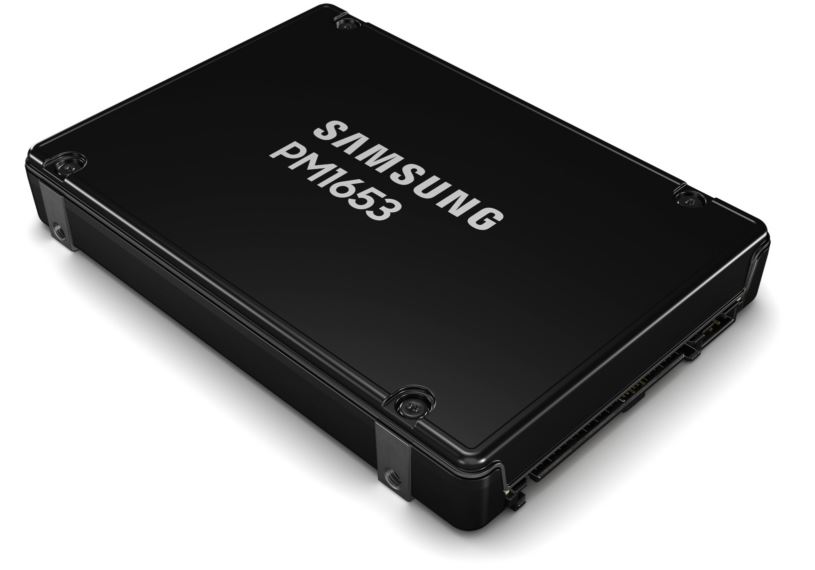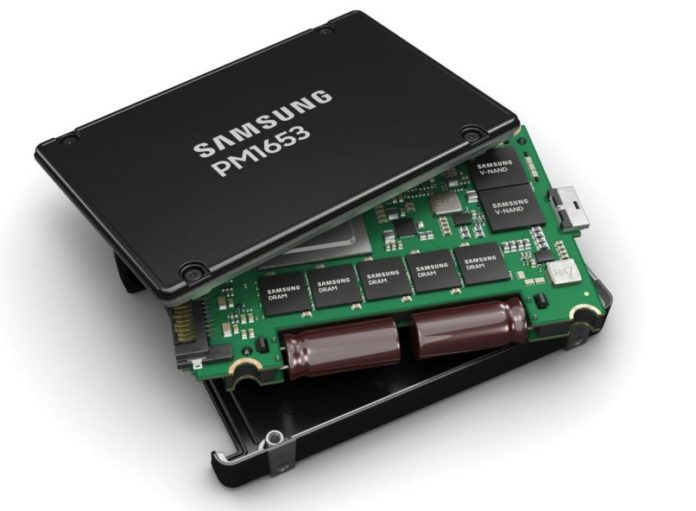Despite NVMe being the future, SAS is still widely deployed in enterprise storage arrays and in enterprise servers. While SATA ran out of performance headroom as we discussed in our Kioxia CD6 PCIe Gen4 NVMe SSD review, SAS is able to continue scaling to higher bandwidth levels, the next being SAS4 which is a 24Gbps interface (SATA III is 6Gbps for reference.) For this next-generation storage interface, Samsung has a new SSD. Dubbed the Samsung PM1653, the company is announcing the drives before mass production later in 2021.
Samsung PM1653 24G SAS4 SSDs
The Samsung PM1653 is the company’s first 24G SAS SSD. It will be built using the company’s 6th generation V-NAND chips.

Samsung says capacities are expected to range from 800GB to 30.72TB. Random performance is supposed to hit around 800K IOPS and sequential read speeds of around 4.3GB/s. As one would expect with modern data center NVMe SSDs being significantly faster, this performance is being limited by the 24G SAS interface, not the NAND technology.
Final Words
The major challenge in the industry is that 24G SAS (SAS4) drives will hit the market in the second half of 2021. We also need PCIe Gen4-based SAS4 controllers to be widely available and systems to be validated. It is likely we are going to see 24G SAS adoption around the time that PCIe Gen5 and CXL hit the market in 2022 which means that SAS SSDs will again seem more than a generation old. The new Samsung SSDs can hit 4.3GB/s in sequential reads, but its consumer M.2 SSD, the Samsung 980 Pro we reviewed in 2020 is hitting 50% or more read throughput than the future SAS drive launched in late 2021. Granted, they are very different drives, with different deployment scenarios and workload optimizations, but that is the challenge. 24G SAS is coming out with PCIe Gen4 out-pacing drives, and just as the PCIe Gen5 drives will be close to hitting the market. From a timing perspective, delaying storage purchases will likely see 3x the performance per device by waiting for next-gen PCIe Gen5 NVMe SSDs.
Still, there is a market for SAS, but it seems like the primary market is going to be in legacy systems that have not made the jump to newer PCIe infrastructure. We purchase SSDs for higher performance, and 24G SAS helps, but is notably falling behind NVMe storage technology.





i wonder why still using 2.5 inch form factor ? why not 3.5 inch with much more storage capacity ?
SAS4 drives are great but the real benefit will be SAS4 expanders for bulk storage. Speed isn’t as high of priority here but it’ll certainly be welcomed, especially as bulk storage continues to migrate from spinning rust to SSD.
What’s up with those two electrolyte capacitors doing in that SSD?
@logoffon
They are for data integrity in case of sudden power loss.
Since 4.3 GB/s limitation is due to SAS4 interface not NAND chip then I think it will be better to manufacture NVMe instead. I understand during SAS3 & below days NVMe was not so popular that is why the industry invested heavily in SAS3 & you can see 12G SAS3 SSD Drive is more expensive than NVMe just because enterprises already invested in SAS3. I think moving forward the industry need to be more focused on NVMe. I know someone will say that SAS controller can address high number of drives “1024” using a single controller but that will be on the expense of throughput and SAS4 will double that. But if that is the case & the focus is on bulk storage then 24G SAS4 “Which I expect will be more expensive than it is NVMe counter drive” will not be a great choice.
Recently I was trying to upgrade a Supermicro Storage Server with a 12G SAS3 SSD. The only reason NVMe was not an option because you need to replace Backplane, Controller & cables which is beyond budget so you can understand where I’m coming from
I think only time will tell how marker will adopt this technology
Thanks again Patric & STH Team for keeping us uptodate
SAS SSDs have their place, and for some time NVMe drives still command a price premium and when you need a system that is for bulk storage (file storage for example) Capacity is a little more important than blistering speed.
I’m only familiar with older SAS generations (sadly, I’m on the home-lab-scavenging-behind-the-times budget); but with the hardware of that time the big advantage of SAS(aside from the fact that hardware of that time doesn’t know most or all NVMe storage standards are) was that it was fairly tolerant of external cable runs to drive shelves and JBOD boxes of various sorts(at least within the rack); and SAS expanders were cheap, ubiquitous; and SAS HBAs could be relied upon to not freak out if you added one. By contrast, PCIe cabling outside the chassis was a comparatively demanding business; and depending on fiddly details of PCIe bifurcation support and other platform firmware details the ease of adding more downstream devices than the motherboard expected varied from ‘not bad’ to ‘not feasible’.
Can anyone with a more contemporary budget tell me how these two factors stack up now? Has SAS4 given up anything in terms of being tolerant of fairly middling cables and reasonable length for the additional speed? Are NVMe equivalents of port multipliers now ubiquitous and reliable; or are those still ‘vendor x motherboard will work with vendor x backplane and vendor x expansion shelf’?
@Erik “why still using 2.5 inch form factor ? why not 3.5″
Because 3.5″ drives are actually 4″ wide. A 2U rack is 3.5″ tall. That means in a 2u rack you can either have 24 hot swap 2.5″ drives or 12 3.5” drives. Double the drive capacity.
If your NVME Gen4x4 slot is limited to 8GB/s then you can get 24*8 = 192GB/s vs 96GB/s of array speed.
Bulk storage is one thing, but 8TB of spinning metal is still vastly less expensive than 8TB of SSD, whatever the interface.
Do NVMe drives support dual Controllers? That’s the only advantage I see, SAS4 drives are dual ports.
Many of the high-end NVMe drives are dual ported.